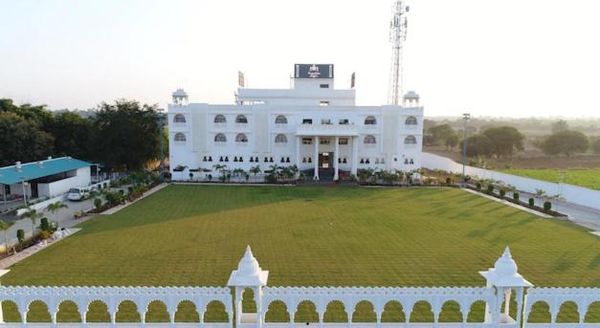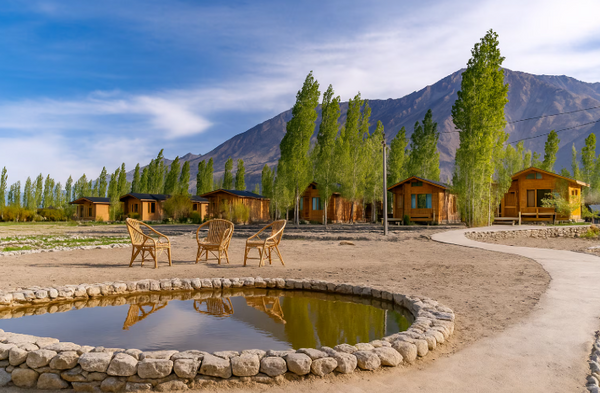Badrinath Dham Temple: Rituals, History, Weather, How To Reach & More
 Mountains Curve
03 Aug, 2025
29 mins read
205
Mountains Curve
03 Aug, 2025
29 mins read
205
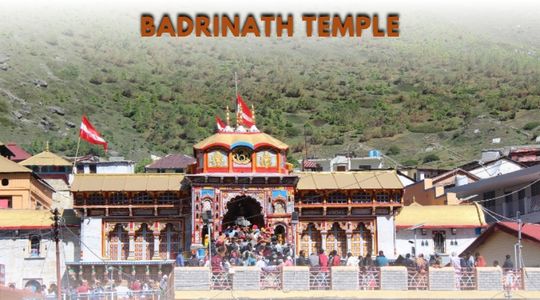
Badrinath Dham is one of the most revered pilgrimage sites in Hinduism. It is home to the ancient Badrinath Temple, a shrine dedicated to Lord Vishnu (worshipped here as Badrinarayan).
Situated in the Chamoli district of Uttarakhand in the Garhwal Himalayas, the temple town lies at about 3,100 meters above sea level on the banks of the Alaknanda River. Badrinath is celebrated as one of the 108 Divya Desams (holy abodes of Vishnu) and is counted among the four sacred Char Dham pilgrimage sites of India.
In Hindu tradition, a pilgrimage to the Char Dham (Badrinath, Dwarka, Puri, and Rameswaram) is believed to grant moksha (salvation). The town is also part of the Panch Badri circuit (including Adi Badri, Bhavishya Badri, Yog Badri, and Vriddha Badri).
In short, Badrinath is a spiritual magnet attracting millions of devotees each season, as its name Badri (wild berry tree) recalls the legend of Lakshmi protecting Vishnu under a Badari tree.
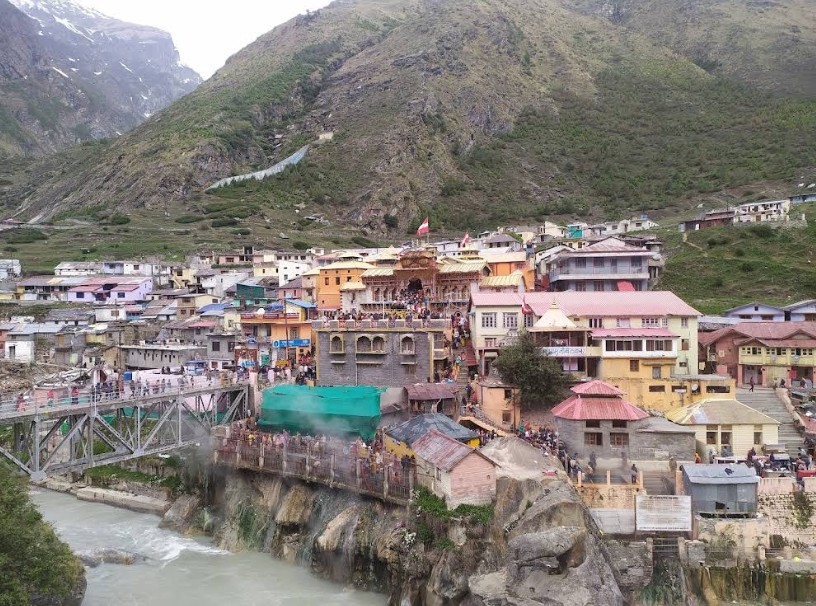
View of Badrinath Dham
Badrinath Temple
The central landmark of Badrinath Dham is the Badrinath Temple itself. Architecturally, the temple is built of stone with a distinctive facade of arched windows and a tall entrance (Singhdwar). It has three main parts: the Garbha Griha (inner sanctum), the Darshan Mandap (pillared worship hall) and the Sabha Mandap (assembly hall).
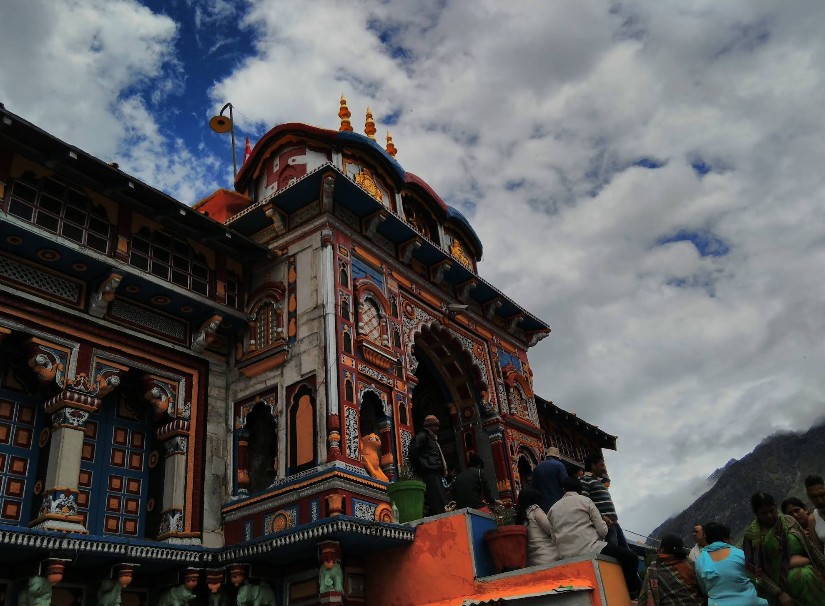
Singhdwar of Badrinath Temple
A broad stairway leads up to the Singhdwar, which is colorfully decorated and guarded by a life-sized idol of Garuda (eagle mount of Vishnu) in prayer. The temple building itself is about 15 meters high with a conical shikhara and a small gilded cupola on top. Walls and pillars inside the mandap are intricately carved.
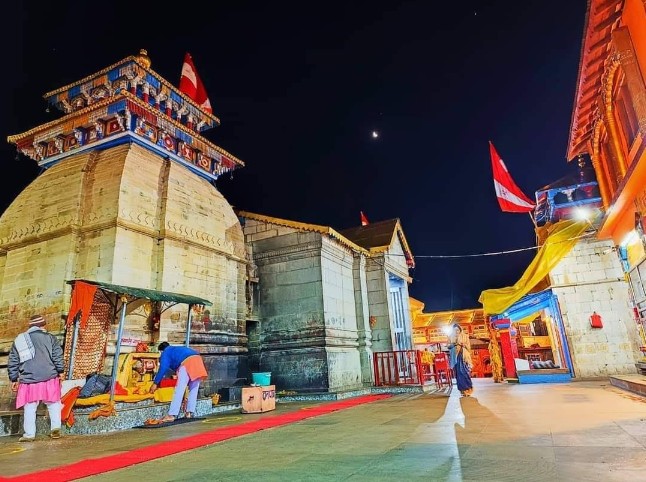
View after entering in Singhdwar
In the inner sanctum sits the main Shaligram idol of Lord Badrinarayan (Vishnu), a 1 feet tall black stone image of Vishnu in a meditative (yoga) pose under a canopy formed by a Badari (berry) tree.
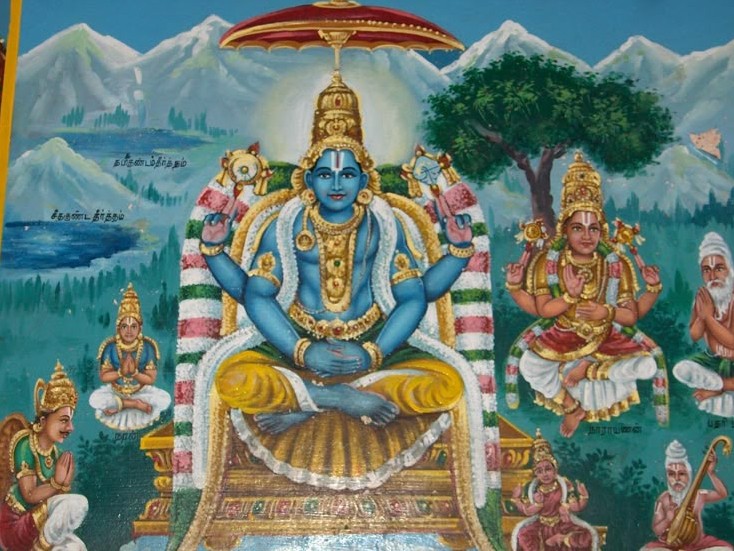
Lord Badrinath Ji
This idol holds symbols (shankha and chakra) of Vishnu in two hands and has the other two hands in yogic posture. The sanctum also houses subsidiary deities including Kubera (god of wealth), Nar and Narayan (the twin sages), and Goddess Lakshmi, all facing the main deity.
Pilgrims visit daily to offer prayers and partake in a series of rituals. The temple opens early each morning (around 4:30 AM for the first mangal aarti) and closes late in the evening. Typical darshan hours are roughly 4:30 AM to 1:00 PM and 4:00 PM to 9:00 PM (seasonal variations may apply). Each day features multiple aartis (ceremonial worship with lamps), bhog offerings, Vedic prayers and recitations.
For example, priests begin the day with the Mangala Aarti at dawn, followed by various worship services throughout the morning. Lunch-time Pradakshina offerings are held, and evening concludes with the Shayan Aarti (putting the Lord to rest) before closing. (Pilgrims can often book special pujas online through the temple committee website.)
The entire temple complex, including the Bara Mandap assembly hall, is infused with devotional hymns and ritual flames at every hour of open darshan.
Architecture and Deities: The colorful Singhdwar of the temple is its iconic gate. Inside, pilgrims see the golden canopy above the shrine and carved columns around the pillared hall. The main idol of Lord Badrinarayan is seated in Padmasana (lotus pose) and flanked by Lakshmi, Garuda, Kubera, Narada, Nar, Narayana and a silver Ganesh, all under the Badari tree canopy.
According to legend, Adi Shankaracharya discovered this Saligram idol in the Alaknanda River near Narad Kund and first enshrined it in a cave by the Tapt Kund hot springs (below). In the 16th century the Garhwal king moved the idol to the present temple site. A Svayamvyakta Kshetra (self-manifested shrine) of Vishnu, it is greatly revered for its antiquity and holiness.
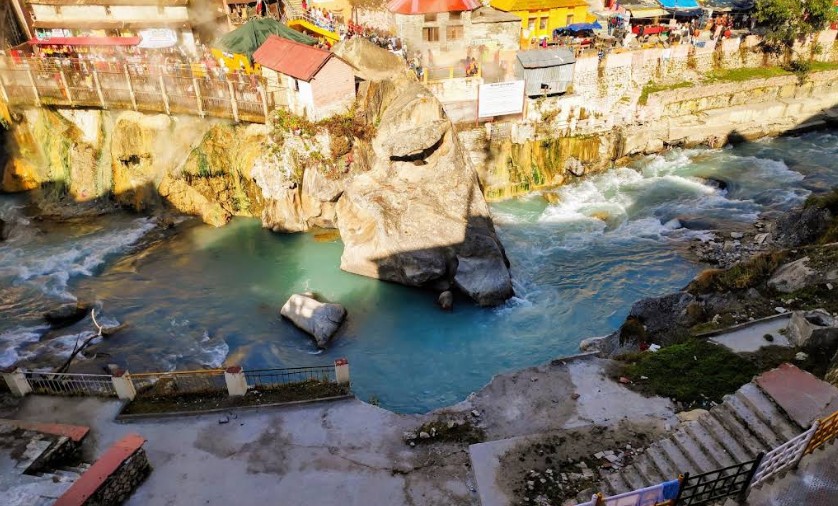
View of Narad Shila, Narad Kund in behind the Shila and the Alaknanda River
Daily Rituals & Timings: On a daily basis, devotees can see (and in many cases join) the traditional worship. The temple opens in the very early morning (often before sunrise) with the Mangala Aarti. The priests perform various pujas, and a silver-palankin procession may be held on special occasions. Darshan (visiting the shrine) remains open roughly 6 to 7 hours in the morning and 4 to 5 hours in the evening. The exact timings can vary by season; however, a typical schedule is:
- Morning Darshan: ~4:30 AM to 1:00 PM (includes early Mangala Aarti, Abhishek rituals, special offerings).
- Evening Darshan: ~4:00 PM to 9:00 PM (Sandhya Aarti, Shayan Aarti).
- After the evening Aarti (around 9 PM), the temple doors close for the night. On Mondays (the day of Lord Shiva) and during festivals, extended rituals and special alankars (decorations) are observed.
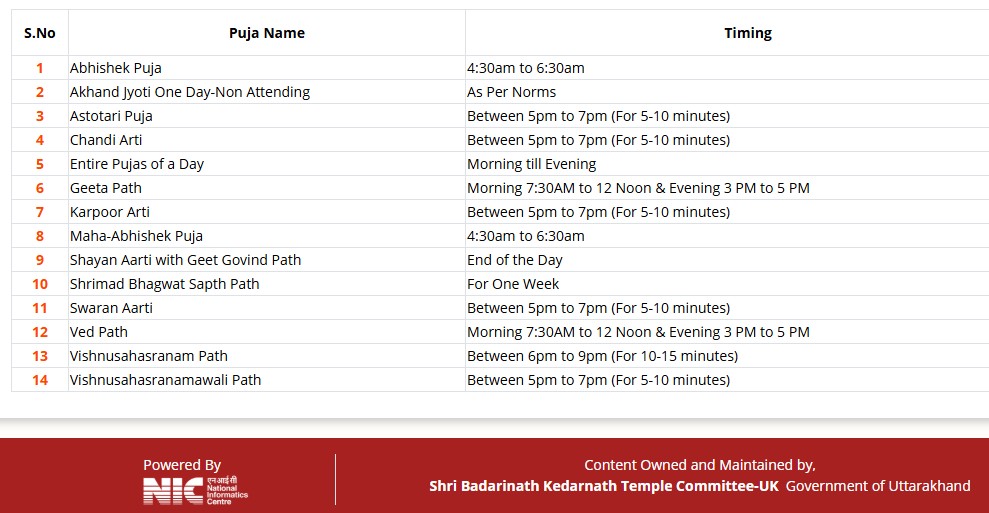 Daily Rituals and timings at Badrinath Temple (by Shri Badarinath Kedarnath Temple Committee-UK)
Daily Rituals and timings at Badrinath Temple (by Shri Badarinath Kedarnath Temple Committee-UK)
History and Mythology of Badrinath Ji
The history of Badrinath is a tapestry of Puranic legend and medieval revival. Legends state that Lord Vishnu performed severe penance at this spot and was shielded from the cold sun by Goddess Lakshmi in the form of a berry tree (Badari tree).
Grateful, Vishnu named the place Badrika Ashram. This myth is commemorated by the Badari-tree shrine temple and by the town name.
Other legends link the area to great sages: e.g. Sage Nara and Narayana (twin forms of Vishnu) performed penance here, and legendary yogis Kapila Muni, Gautama, and Kashyapa once meditated in these mountains.
The Pandavas of the Mahabharata are also said to have traveled this way on their final journey to heaven, the nearby peaks of Swargarohini were considered the stairway to heaven.
A famous folklore is the Bhim Pul, a natural stone bridge over the Saraswati River near Mana Village, said to have been placed by Bhima for Draupadi to cross.
The great sage Veda Vyasa is believed to have written the Mahabharata here, and a cave above Mana (Vyas Gufa) is still worshipped as the spot where he composed his Vedas.
Historically, the site was likely known since Vedic times, but it fell into disuse in the early medieval period. It was Adi Shankaracharya (8th to 9th century CE) who re-established the temple and revived Badrinath as a pilgrimage center.
According to the Skanda Purana and local tradition, Shankaracharya recovered the black Saligram idol from the Alaknanda and enshrined it at Badrinath.
He is said to have built or renovated the original temple (an event dated to the 8th century by the temple committee) and installed priests to manage the shrine. Thereafter the Garhwal kings continued patronage: in the 12th to 16th centuries the temple was rebuilt multiple times after avalanches and earthquakes.
King Laxmi Chand of Garhwal (17th century) built much of the present structure. The temple inscriptions and later historians credit Shankara with giving Badrinath its lasting fame, at a time when Buddhism was rising in the Himalayas, Shankara established key shrines for Vishnu and Shiva in the hills (including Badrinath and Kedarnath) to revive Hindu dharma.
Scriptural references also underscore sanctity of the Badrinath. It is mentioned in ancient texts like the Vishnu Purana and Skanda Purana.
The Tamil Nalayira Divya Prabandham (6th to 9th c. CE Alvar hymns) glorifies Badrinath as Badari Vishal, the great holy place of Vishnu.
In short, myth and scripture tell of gods and rishis, Nara-Narayana, Vishnu-Krishna, Lakshmi, the Pandavas and great sages, all favoring this Himalaya shrine. Pilgrims today still invoke these legends when they undertake the arduous journey, believing it is the same sacred ground trod by divinities.
Weather and Best Time to Visit
The high-altitude Badrinath setting means the climate is extreme in winter and cool in summer.
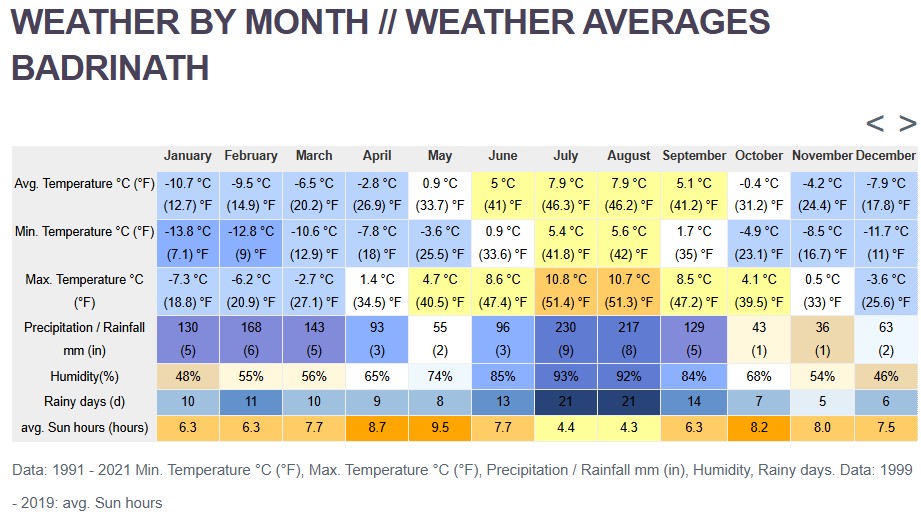
Weather at Badrinath as per data from 1999 to 2019 | Data Source by climate-data.org
Winter (Oct to Apr) brings heavy snowfall and sub-zero temperatures.
By late autumn the roads are blocked by snow, and the temple is closed (each year around Dussehra or Diwali) until spring.
In fact, the 2024 closing ceremony was held on Vijaya Dashami (Nov 17) at 9:07 PM.
Summer (May to June) is pleasantly cool (daytime ~15 to 20 degree celsius, nights chilly) and is the main pilgrimage season. Badrinath usually opens in early May (during the auspicious month of Vaisakha, typically on Akshaya Tritiya) and the weather then is clear, making all routes passable.
Monsoon (July to mid-Sept) brings frequent rains and risk of landslides in the mountain roads. Temperatures moderate (10 to 18 degree celsius) but heavy rain can disrupt travel.
By September to October the rains taper off and the valley is green with blooming flowers; early autumn is considered a second good window (though weather can turn cold by late Oct).
In summary, the best time to visit is late May to June and then late September to early October. The official open season of the temple is roughly end-April through early November.
Outside this window the shrine is closed and the town is under snow. Major local festivals during the open season include Mata Murti Ka Mela (September, a fair celebrating the arrival of the Ganges), Janmashtami and other Hindu holy days.
On the final day (Vijayadashami), elaborate closing rituals (panch-puja and procession) are performed as the deities are put to sleep for winter.
How to Reach Badrinath
Reaching Badrinath requires planning, as the shrine is remote high in the Himalayas:
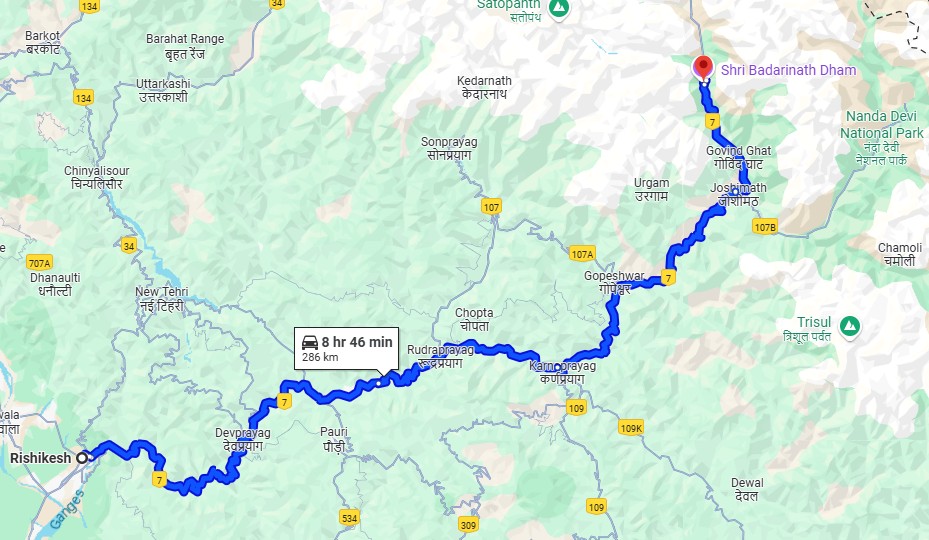
Rishikesh to Badrinath via Srinagar, Devprayag, Karnprayag, Joshimath and Govind Ghat | National Highway 7
- By Air: The nearest airport is Jolly Grant Airport near Dehradun (serving Uttarakhand). Dehradun is about 310 to 315 km from Badrinath by road. From Dehradun one can hire taxis or take a bus via Rishikesh, Devprayag, Srinagar, Chamoli and Joshimath.
- By Train: The closest railhead is Rishikesh (Haridwar is also an option). Rishikesh is roughly 290 to 295 km from Badrinath, a 8 to 9 hour drive via Devprayag and Karnaprayag. Trains to Rishikesh are frequent from Delhi, Chandigarh and other major cities. From Rishikesh many state-run and private buses, or shared taxis, connect to Badrinath during the pilgrimage season.
- By Road: Badrinath is well connected by National Highway (NH 7, formerly NH58) through the Garhwal valley. From Delhi, pilgrims often drive (or take a Volvo bus) to Haridwar/Rishikesh (~230 km) and onward to Badrinath (~330 km more). There are regular bus services from Kashmere Gate (ISBT) in Delhi to Rishikesh/Haridwar, and onward buses from Rishikesh/Srinagar (Uttarakhand) to Badrinath. The final stretch through Joshimath to Badrinath is along winding mountain roads; travel time from Rishikesh is generally 10 to 12 hours by road.
- By Helicopter: In recent years helicopter services (charter flights) have become available for the Char Dham pilgrimage. Helicopters from Dehradun or Pithoragarh can land at the Badrinath helipad (in Joshimath or Badrinath), saving many hours of travel. These must be booked in advance through licensed operators (often on fixed dates during clear weather).
- Road Conditions: The mountain highways are asphalt but narrow with many hairpin bends. During summer they are generally open and maintained, but in monsoon or winter high winds/landslides can block sections. Travelers should allow extra time and use local drivers familiar with the terrain. State-run roadside dhabas and rest stops (e.g. at Rudraprayag, Karnaprayag, Chamoli) serve simple meals en route.
Accommodations
Badrinath offers a range of lodging options for pilgrims, from basic guesthouses to hotels:
- Government (GMVN) Guesthouses: The Garhwal Mandal Vikas Nigam (GMVN) operates tourist rest houses in Badrinath, such as Hotel Devlok and Yatri Niwas. These are economy-class lodgings at subsidized rates. They offer clean, simple rooms (often dormitory and private rooms) with basic amenities like attached bathrooms and hot water. GMVN also has dorms and separate blocks for male and female pilgrims. A GMVN dining hall serves pure vegetarian Uttarakhand meals (dal, sabzi, rice, roti) to guests. Pilgrims can book GMVN accommodations online or at regional GMVN offices before arrival.
- Private Hotels and Resorts: There are many private hotels and lodges in Badrinath town (close to the temple). These range from small family-run inns to mid-range hotels. Examples include Hotel Snow Crest, Badri-Ville Resort, Mountain Trex Huts, and Hotel New Snow Crest, among others. These private lodgings generally offer slightly better amenities (attached washrooms, hot water, WiFi in some) and a variety of rates (mid-range to budget). Booking in advance is wise during peak season, as options can fill up. Many hotels also run small cafeterias or attach to vegetarian restaurants.
- Dharamshalas and Ashrams: Several religious trusts and ashrams in Badrinath provide simple lodging (often dormitory style) for pilgrims. These may be run by various sampradayas (sects) or yoga centers. They typically offer the most basic accommodations (shared bathrooms, mats or cots, communal kitchens). Some charge nominal fees or request donations. For example, the Tulsi Narayan Ashram and Annapurna Ashram (run by local holy men) welcome visiting sadhus and pilgrims with simple lodging. These can be good low-cost options but should be booked or checked via local contacts.
- Nearby (Joshimath/Mana): If Badrinath itself is full, one can stay in Joshimath (35 km away, at ~1,890 m) or in Mana Village (3 km beyond Badrinath). Joshimath has more hotels and rest houses and is a major base for the Char Dham Yatra. Mana Village, being very small, has only a few guesthouses.
In all cases, advance booking is recommended in summer months. The Uttarakhand tourism website and GMVN portal provide official booking platforms. Facilities at Badrinath are modest: hot water may be limited, electricity can be patchy, and hygiene standards vary. But pilgrims generally prioritize location and availability over luxury.
Nearby Attractions
Several sacred and scenic sites are clustered around Badrinath, many within a few kilometers. Pilgrims often explore these on foot or via short treks:
- Tapt Kund (Hot Springs): Just a few steps below the temple, Tapt Kund is a natural hot water spring enclosed in a bathing pavilion. The water is warm year-round and reputed to have medicinal properties (helping with skin ailments). Devotees traditionally bathe here before entering the temple. According to legend, a tortoise (Kurma) and snake (Naga) story is associated with these springs. (Tapt Kund is one of the Char Dham Nava-Siddha pilgrimage spots.)
- Mana Village (God Village): About 3 km north of the temple lies Mana, the last inhabited village on the India-Tibet border. At ~3,200 meters altitude, Mana is a picturesque Bhotia settlement on the Saraswati River. It has several small temples and legendary sites. The village was declared a Tourism Village by Uttarakhand. Highlights here include:
- Vyas Gufa: A cave where Sage Ved Vyasa is said to have composed the Mahabharata. Its roof famously has rock grooves that devotees call writing pages of the Maharishi Vyasa. A small shrine to Vyasa inside the cave is worshipped.
- Ganesh Gufa: A cave where it is said Lord Ganesha (as scribe of Veda Vyasa) paused from dictating the Mahabharata.
- Charan Paduka: A rock shrine bearing the footprints of Lord Vishnu. It stands on the lower slopes of Nar Parbat about 3 km from Badrinath. Pilgrims hike (~1.5 hr climb) to see the imprints, which are said to be where Vishnu first stepped on earth.
- Bhim Pul: A natural stone bridge over Saraswati, legendarily created by Bhima for Draupadi.
- Saraswati Temple: The Saraswati River is said to disappear underground near Mana; a temple is being built at that spot to honor the goddess.
- Vasudhara Falls: From Mana, a popular 6 to 7 km trek (moderate difficulty) leads to Vasudhara Falls. The falls drop about 400 m and are very scenic, surrounded by meadows and snow peaks. Pilgrims believe the Pandavas once camped here during their exile. The trek takes a few hours one-way, crossing streams and lush alpine fields. (The Shrine Board ticket for Badrinath generally includes Vasudhara access as well.)
- Brahma Kapal: About 500 m from the temple on the banks of Alaknanda is Brahma Kapal (the Pot of Brahma). It is a cremation/ancestral rites ghat. Hindus believe that performing shraddha rites here honors ancestors and can liberate their souls from the cycle of rebirth. It is so sacred that many pilgrims cremate their elderly relatives here. A small shrine to Lord Brahma presides over the platform. Even non-Hindus find the quiet riverside spot worth visiting.
- Mata Murti Temple: A little below Tapt Kund lies a small temple devoted to Mata Murti, the mother of Lord Narayana (Vishnu). Legend says Vishnu granted her the boon of birthing His twin forms (Nar and Narayan) here. The temple holds a fair (Mata Murti Ka Mela) in August to September, drawing thousands of women in honor of the divine mother.
- Valley of Flowers National Park: Just 25 km from Badrinath, Valley of Flowers is a UNESCO World Heritage Site famous for its vibrant alpine blooms and scenic trekking trails. Open from July to early September, it is a must-visit for nature lovers exploring the Badrinath region. The trek starts from Govindghat and gradually covers the distance of around 40 kilometers round trip within 5 to 6 days. The route passes through lush forests, waterfalls, and wooden bridges. It includes a steep climb and offers rewarding views of the snow-capped peaks surrounding Hemkund Sahib. Ghangaria serves as the base camp for the trek, from where you can either enter the Valley of Flowers National Park or hike to Hemkund Sahib.
Pilgrims often walk or hire local guides for day trips to these sites. The air is thin, so allow extra time and ascend slowly when trekking.
Travel Tips and Essentials
- Clothing: Even in summer, days are cool (~15 to 20 degree celsius) and nights can drop to 0 to 5 degree celsius. Bring warm layers (fleece, wool sweaters, jacket), a windproof/rain jacket, gloves, and a hat. Good trekking shoes are essential if you plan any hikes. Sunglasses and sunscreen are a must due to intense UV at high altitude.
- Altitude Sickness: Badrinath is at ~3,100 m. Some visitors may feel mild altitude effects (headache, fatigue) especially if coming directly from low elevations. To acclimatize, take it easy on the first day: rest, drink plenty of water, avoid alcohol and heavy meals. Over-the-counter Diamox (acetazolamide) can help prevent altitude sickness (consult a doctor). Descend and seek help if symptoms worsen. Always listen to your body and go slowly.
- Permits and ID: Indian citizens need a photo ID (Aadhaar card, voter ID or passport) for registration. Foreign nationals should carry a passport and any required permits (Uttarakhand does not generally require special Inner-Line Permits for Badrinath, but rules can change near border areas). All pilgrims must register for the Char Dham Yatra (online or at checkposts) during the open season.
- Food and Water: Vegetarian food is the norm. In and around the temple you will find small shops and restaurants serving simple North Indian fare, dal, rice, curries, roti, snacks and tea. Carry some dry snacks (biscuits, nuts) for the journey, and stay hydrated (drink boiled/bottled water). Hot herbal teas or millets soups are popular at high altitudes.
- Health & Emergency: A basic dispensary operates in Badrinath during yatra season, and there are emergency numbers posted at the temple (e.g. Chamoli district control room 1077 or 01372-251437). Many hotels provide oxygen cylinders for emergencies. Travel insurance (including evacuation) is advised for all. Keep emergency contacts handy: the Uttarakhand Disaster Response teams are prepared for high-altitude rescues.
- Temple Etiquette: Dress conservatively (legs and arms covered). Footwear must be left outside the temple premises. Photography inside the main temple is prohibited. Women observing their first menstrual cycle do not enter the main temple; a small shrine near Tapt Kund is set aside for them.
- Booking and Facilities: During peak season (May to June, Sep to Oct), Badrinath gets crowded. Book accommodations and any special puja or helicopter tickets in advance if possible. The Badrinath-Kedarnath Temple Committee website (badrinath-kedarnath.gov.in) provides info and online services. ATMs are extremely scarce (cash withdrawals only at road heads like Joshimath); carry sufficient cash.
- Local Customs: Badrinath is primarily a Vaishnavite (Vishnu-worship) center. Devotees often circumambulate the main temple and offer 1000+ Mala (1000-bead garlands) or boiled rice. The tradition of Char Dham Parikarma (clockwise circumambulation) is believed meritorious. Pilgrims often recite the Vishnu Sahasranama at the Bal Shesh Naag temple outside. Treat all rituals with respect and silence, especially during aartis.
Spiritual Significance and Pilgrimage Importance
The sanctity of Badrinath is profound. As one of the Char Dham in Uttarakhand (along with Gangotri, Yamunotri, and Kedarnath), it represents the embodiment of Lord Vishnu.
Hindu scriptures declare that even a single pilgrimage to the shrines of Badrinath can purify a soul from sins. The Char Dham yatra as a whole is said to guarantee moksha (final liberation) to the devotee.
Locally, Badrinath is often called Badari Vishal (the great abode of Badari), highlighting its divine patron. The inner idol of the temple is revered as a self-manifested (svayambhu) form of Vishnu, meaning it was not man-made.
For Vaishnavas (Vishnu devotees), a visit here, along with Char Dham, is a supreme act of devotion. Each year the opening (Pran Pratishtha) and closing (Pahraan or Paal Utsav) ceremonies of the temple are grand affairs.
The auspicious Akshaya Tritiya (April/May) marks the reopening: early morning Vedic rituals are performed as the chief priest (Rawal) ceremonially reawakens the deity.
In autumn, the temple is closed on Dussehra/Vijayadashami (usually October) with solemn rites.
In 2024 the closure was on Nov 17 at 9:07 PM, after which sacred books and lamps were taken away for winter.
These rituals underscore that Badrinath Dham follows an eternal cycle of retreat and return, mirroring the cosmic cycle.
Finally, many pilgrims regard the entire journey, through steep gorges, dense forests and high passes, as itself a spiritual trial. Overcoming the physical hardships of the route is seen as part of the penance.
In this way, Badrinath remains not only an architectural marvel but a living tradition: a gateway to the divine and, by belief, a path to salvation.
Written By:
Mountains Curve



Hotels at your convenience
Now choose your stay according to your preference. From finding a place for your dream destination or a mere weekend getaway to business accommodations or brief stay, we have got you covered. Explore hotels as per your mood.

